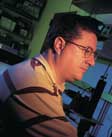 DNA
repair shop "Cancer is a disease of damaged genes," Kowalczykowski said. "If DNA repair is defective, you become cancer-prone. In principle, if you repair the genes, you could stop this process." Kowalczykowski is working with scientists at Lawrence Livermore National Laboratory to understand this process, particularly the repair of double-stranded DNA breaks and how enzymes fix these breaks. Your body already knows the most accurate way to fix bad genes; it's called homologous recombinatorial repair. Enzymes known as genetic recombination proteins scan DNA for damaged genes, then fix them by making a good copy of the gene and swapping out the bad gene for the good one. It's called homologous because the enzymes put the repaired gene back into the chromosome in exactly the same places as the damaged one. It happens automatically - usually. "These enzymes patch up DNA," said Kowalczykowski. "The process is 99 percent accurate."
Home |
Table of Contents |
To our Readers |
Building on Basics UC Davis Health System | © 2000, 2001, 2002 UC Regents. All rights reserved. |
Piero
Bianco, a researcher in Stephen Kowalczy- |

